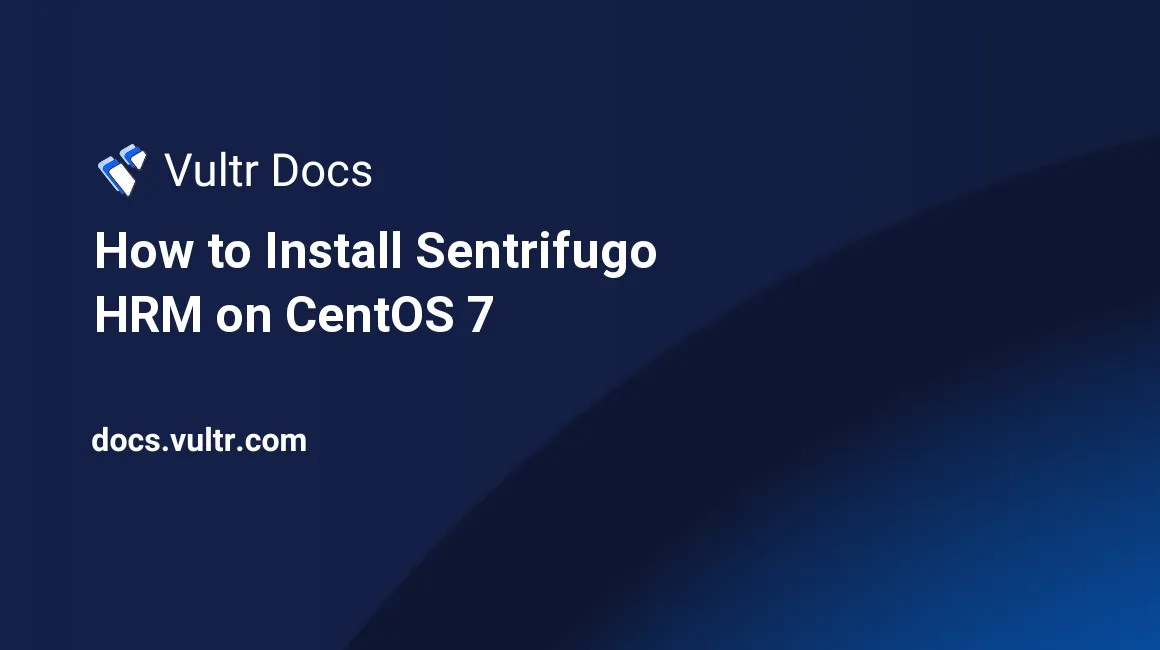
Sentrifugo HRM is a free and open source Human Resource Management application. It is a feature-rich and easily configurable application. It is written in PHP and uses MySQL/MariaDB to store its database. You can use Sentrifugo to track the employee's performance, vacation dates, roles, privileges and much more. It comes with a performance appraisal module which helps the HR managers track the performance of the employee over time. It contains numerous features which are required for day to day employee management, such as employee self-service, powerful analytics, easy background checks, leave management, expenses, and asset management.
Prerequisites
- A Vultr CentOS 7 server instance with at least 2GB RAM.
- A sudo user.
For this tutorial, we will use hrm.example.com as the domain name pointed towards the Vultr instance. Please make sure to replace all occurrences of the example domain name with the actual one.
Update your base system using the guide How to Update CentOS 7. Once your system has been updated, proceed to install the dependencies.
Install Apache
Install Apache.
sudo yum -y install httpdStart Apache and enable it to automatically run at boot time.
sudo systemctl start httpd
sudo systemctl enable httpdInstall PHP 5.6
Add and enable the Remi repository as PHP version 5.6 is not available by default in the yum repository.
sudo rpm -Uvh http://rpms.remirepo.net/enterprise/remi-release-7.rpm
sudo yum -y install yum-utils
sudo yum-config-manager --enable remi-php56Install PHP version 5.6 along with the modules required by Sentrifugo HRM.
sudo yum -y install php php-gd php-mysqli php-mbstring php-curl php-cli php-pear php-devel php-opensslEdit the loaded PHP configuration file.
sudo nano /etc/php.iniFind the following line. Uncomment and set appropriate timezone.
date.timezone = Asia/Kolkata
;Replace "Asia/Kolkata" with your appropriate timezone
memory_limit = -1Install MariaDB
MariaDB is a fork of MySQL. Add the MariaDB repository into your system. The default yum repository contains an older version of MariaDB.
echo "[mariadb]
name = MariaDB
baseurl = http://yum.mariadb.org/10.2/centos7-amd64
gpgkey=https://yum.mariadb.org/RPM-GPG-KEY-MariaDB
gpgcheck=1" | sudo tee /etc/yum.repos.d/mariadb.repoInstall MariaDB.
sudo yum -y install mariadb mariadb-serverStart MariaDB and enable it to automatically start at boot time.
sudo systemctl start mariadb
sudo systemctl enable mariadbBefore configuring the database, you will need to secure MariaDB first.
sudo mysql_secure_installationYou will be asked for the current MariaDB root password. By default, there is no root password in a fresh MariaDB installation. Press the "Enter" key to proceed. Set a strong password for the root user of your MariaDB server and answer "Y" to all of the other questions that are asked. The questions asked are self-explanatory.
Log into the MySQL shell as root.
mysql -u root -pProvide the password for the MariaDB root user to log in.
Run the following queries to create a database and a database user for the Sentrifugo installation.
CREATE DATABASE hrm_data CHARACTER SET utf8 COLLATE utf8_general_ci;
CREATE USER 'hrm_user'@'localhost' IDENTIFIED BY 'StrongPassword';
GRANT ALL PRIVILEGES ON hrm_data.* TO 'hrm_user'@'localhost';
FLUSH PRIVILEGES;
EXIT;You can replace the database name hrm_data and username hrm_user according to your choice. Please make sure to change StrongPassword to a very strong password.
Install Sentrifugo HRM
Download the Sentrifugo HRM zip archive.
wget http://www.sentrifugo.com/home/downloadfile?file_name=Sentrifugo.zip -O Sentrifugo.zipInstall unzip.
sudo yum -y install unzipExtract the archive.
sudo unzip Sentrifugo.zip -d /var/wwwChange the name of the directory and provide the appropriate ownership.
cd /var/www
sudo mv Sentrifugo_*/ sentrifugo/
sudo chown -R apache:apache /var/www/sentrifugoAllow HTTP traffic on port 80 through the firewall.
sudo firewall-cmd --zone=public --permanent --add-service=http
sudo firewall-cmd --zone=public --permanent --add-service=https
sudo firewall-cmd --reloadCreate a virtual host
Create a virtual host for your Sentrifugo HRM site.
sudo nano /etc/httpd/conf.d/hrm.example.com.confPopulate the file.
<VirtualHost *:80>
ServerName hrm.example.com
DocumentRoot /var/www/sentrifugo
<Directory /var/www/sentrifugo>
Options Indexes FollowSymLinks MultiViews
AllowOverride All
Order allow,deny
allow from all
</Directory>
</VirtualHost>Restart Apache.
sudo systemctl restart httpdWrapping Up
Now that you have successfully installed Sentrifugo HRM through the command line, you will need to finish the installation through the web interface. You can access the web installer on http://hrm.example.com. If you have followed the tutorial correctly, you should see that you have all the prerequisites satisfied to continue web-based installation. Provide the database and SMTP server details. Once you have provided the required database and SMTP server details, the setup will write into the database and a random username and password will be generated. Login to the HRM dashboard and configure the application according to your needs.
Congratulations, you have successfully installed Sentrifugo HRM on CentOS 7 server.
No comments yet.